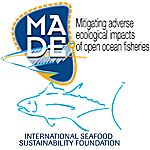Currently, French tropical purse seiners in the Indian Ocean release all sharks and rays that are caught incidentally. Through participation in two commercial fishing trips, we first recorded the number of sharks (primarily silky sharks, Carcharhinus falciformis) that were alive or dead, once they had been sorted by the crew on the upper and lower decks. More sharks were observed in the lower deck (73%) than in the upper deck. The silky sharks observed on the upper deck were significantly larger than the ones found in the lower deck. The immediate mortality (sharks that were dead at the time of observation) rates appeared to be linked with the location of the individual, as more sharks were found dead on the lower deck than the upper deck. The immediate mortality rates also increased with the set size (tonnage). 20 silky sharks were tagged with MiniPATs (Wildlife Computers, Redmond, WA, USA) to study their survival after release. In addition, 12 silky sharks were tagged with the same type of electronic tags during a scientific cruise. Of a total of 32 silky sharks, 8 tags clearly showed mortality directly after release, while data from five tags suggested delayed mortality after 2 to 35 days. 15 tags showed that the sharks survived. Four tags failed to report data. A 'best practices' manual for fishers has been prepared to increase rates of survival of sharks caught by purse seine vessels. However, other methods prior to the sharks being brought onboard must also be investigated.
- Presentation

 PDF version
PDF version
